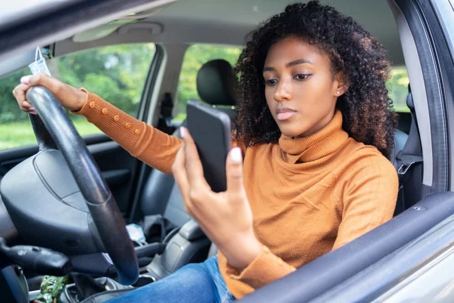Have you ever been on the road and noticed that a nearby driver was not being consistent with their driving patterns? For instance, the driver may have randomly slowed down and then sped back up several times, swerved around in their lane, or didn’t immediately react to changing road conditions.
Oftentimes, when drivers operate their vehicles in such erratic ways, it is because they are distracted.
We often associate the idea of distracted driving with using a phone behind the wheel. While this is likely the most common distraction drivers face, it is not the only way a driver can become distracted. Among others, distracted driving also includes:
- Eating
- Drinking
- Reaching for items around your vehicle
- Tending to a child or pet
Distracted driving in any form is very dangerous. When you read or send a text, your eyes must be off the road for at least five seconds. If you’re traveling at a rate of 55 miles per hour (mph), taking your eyes off the road for five seconds is like driving the length of a football field with your eyes shut.
On average, nearly 9% of all deadly crashes in the U.S. are the result of distracted driving behaviors.
The state of California has put legislation in place to help reduce the number of distracted driving accidents that occur. Here’s what you need to know about California’s distracted driving laws:
California Handheld Device Driving Laws
According to the California State Legislature Vehicle Code §23123.5, “A person shall not drive a motor vehicle while holding and operating a handheld wireless telephone or an electronic wireless communications device unless the wireless telephone or electronic wireless communications device is specifically designed and configured to allow voice-operated and hands-free operation, and it is used in that manner while driving.”
Essentially, the law allows you to use your phone while driving only if you can do so using voice-activated technology as well as hands-free operation.
Additionally, the only other ways you may legally use your phone while driving are under one of the following conditions:
- Your phone must be mounted on your car’s windshield in the same way you’d mount a portable Global Positioning System (GPS), or your phone is mounted or attached to your car’s dashboard or center console in such a way that your view of the road is not obstructed, or
- Your hand is used to activate or deactivate an element or function of your phone with a single swipe or tap of your finger.
If you are caught using your phone in an illegal manner while driving, you may face a fine of $20 for the first offense and $50 for each subsequent offense.
Keep in mind that emergency service professionals who use handheld devices within the scope of their duties while operating authorized emergency vehicles are exempt from these rules.
We’re Here to Help Injured Victims Recover the Compensation They Deserve
As you know, distracted driving is very unsafe. Sadly, thousands of people lose their lives each year as a result of dangerous distracted driving behaviors.
If you’ve been injured in a car accident as a result of a distracted driver’s irresponsible actions, it’s critical that you are able to recover the compensation you deserve to cover your losses. Our team is highly skilled in this area of the law and we have helped many other people in similar situations receive the money they were owed.
Let us see if we can help you too. Don’t delay—reach out to our office with any questions you may have right away.
We offer free consultations. You can get the answers you need when you need them most. Call us today at (916) 476-2399, and get our skilled team on your side!

